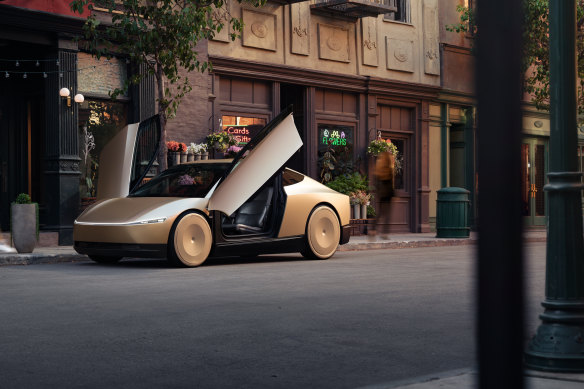
To understand the value the market assigns to it, the company must be viewed as an artificial intelligence firm, with AI serving as its competitive advantage against rivals like Google’s Waymo, which already has driverless cars operating in major US cities using costly sensors.
Loading
Musk has said that, if Tesla can solve autonomy, it would be a $US30 trillion company. After Friday’s plunge in its share price, it is a $US696 billion company.
If autonomous vehicles could be directed by software rather than the mix of expensive hardware and software used by Waymo and others, they’d be far cheaper to make and operate, which is why an AI solution for autonomous driving would transform Tesla’s prospects and validate its valuation.
Musk amplified the focus on robotaxis and Tesla’s humanoid Optimus robot after announcing disappointing earnings earlier this year and amid reports that it had abandoned plans to add a cheaper $US25,000 Model 2 vehicle to its range. There was no update on Model 2 at the event, with the cybertaxis apparently having been awarded priority within Musk’s planning.
At last week’s briefing, despite Musk’s optimism, the disappointed reactions from analysts and investors suggest they believe that a Tesla robotaxi rollout is still far off. The demonstration was limited to a slow, short drive around an enclosed, challenge-free studio set.
Loading
Tesla currently sells software that it calls “Full Self-Driving, (supervised)” or FSD, which still requires the driver to be alert and able to take manual control of the vehicle, with hands supposed to be always on the steering wheel.
Musk said on Thursday that he expects owners of the existing Model 3 and Model Y cars will no longer have to supervise their operation – the cars will be able to drive themselves – sometime next year. The original target date for fully autonomous vehicles was August 2018.
That expectation of a launch next year, however, also came with a caveat because it would require regulatory approval.
Regulators in the US, after numerous accidents involving semiautonomous vehicles – including a number of fatalities – are understandably cautious about the prospect of large numbers of vehicles roaming their streets with their drivers potentially asleep behind the wheel or, if the robotaxis are ever rolled out, without drivers or steering wheels.
It could be years before there is anything more than tightly controlled experiments with driverless vehicles and potentially decades before there are the scale and efficiencies for robotaxi production and operation to be profitable.

There are two seats inside Tesla’s futuristic Cybercab but neither is designed for a driver.Credit:
It was Musk’s unwillingness or inability to provide the detail to address some of the major question marks over the timelines he presented – and the fact that the much-hyped event turned out to be more marketing sizzle than business meat – that caused some investors to dump the shares on Friday.
Along with the centrepiece of the event, the cybertaxi, Tesla also produced an updated version of its humanoid robot, Optimus.
Those robots, which Musk said would be “the biggest product ever of any kind”, mingled with guests and poured drinks at the presentation but, it appears, were not operating autonomously but had a significant level of human supervision and control. He talked about a future where personal robots would do the grocery shopping or mow lawns. A less ambitious, but more obvious, use for the robots would be in factories.
Thus, it would seem, that the other foundation for Musk’s $US30 trillion valuation is also some way off achieving the vision he has for it.
It is those robotaxis and humanoid robots, rather than its more conventional EVs, that underpin its existing market value, which may be a very long way off $US30 trillion but still capitalises a lot of Musk’s visions.
Beyond the challenges with AI, Musk and Tesla face another hurdle: as global growth in electric vehicles slows and excess production – especially in China – drives prices down, Tesla’s EV market share is under pressure. This, in turn, impacts the cash and profits it needs to invest in AI and the development of driverless vehicles.
Competitors like Google, GM and China’s Baidu have also stolen a lead in actually getting fully autonomous vehicles on the roads – Waymo’s fleet, which has been operating for years, is now notching up more than 100,000 rides a week, albeit in quite discrete, heavily mapped and geo-fenced urban areas.
Tesla needs a technology-based breakthrough to leap over them, hence the focus on AI. But apart from the challenges presented by trying to develop the extraordinarily complex software in its cars, it has to convince risk-averse regulators and ultimately equally risk-conscious passengers that its technology is safe.
Musk’s failure to convince his investors and analysts that he has the answers to those challenges at his glitzy event last week turned out to be costly.
The Market Recap newsletter is a wrap of the day’s trading. Get it each weekday afternoon.



























